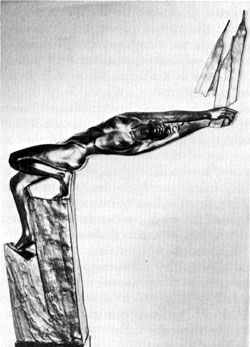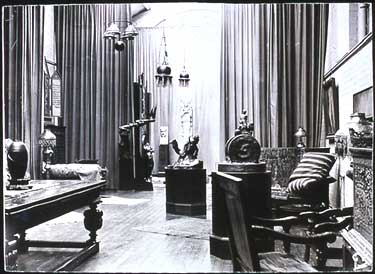John & Katharine Maltwood Collection
| View the Collection |
History of the Collection |
John & Katharine Maltwood |
Information Resources |
The Maltwoods Introduction
Katharine Maltwood Biography
Early Sculpture Post-War Works
- War and Travel - Religious Mysticism - Philosophical Leanings - Style and Outlook - Egyptian Influence - Studio at Kensington - House of Fulfillment - Lily Adams Beck Glastonbury Zodiac Life in Victoria, B.C. Monograph (pdf 1.14 MB)
About Us Contact Us Visit Us Site Map

Post-War Works - Part 6: The Studio at Kensington | ||||
In 1924 Katharine Maltwood won success at the British Exhibition, Wembley when two works, The Mills of God and Aspiration, were awarded diplomas.The latter also went under the title Plucking Feathers from the Eagle's Tail and was inspired by the famous lines from Browning's Andrea del Santo, "Ah, but a man's reach should exceed his grasp, or what's a heaven for?" A bronze relief, it attracted attention due to its daring and original conception. Critics were struck by the curious Z-shaped figure with its outstretched arms suggestive of flight. In style the figure reveals the organic, Rodinesque qualities of her pre-war works. Three years later another new piece appeared. The Daily Sketch published an illustration of Mirage which according to the caption depicted "a traveller hypnotized by the spirit of the desert." Again the experience of her travels is displayed together with the expression of philosophical thought. In contrast to Aspiration, here the Art Deco and Cubist forms suggest her awareness of current artistic trends. Katharine Maltwood's last work of significance seems to have been a bronze monument of oriental inspiration, The Path of Enlightenment, which was exhibited by the Royal Academy in 1929. The artist was then fifty one. The composition may well have been inspired by a verse, referring to the Buddha's enlightenment, which she marked off in Dr. Suzuki's Essays on Zen Buddhism:
The climax to Katharine Maltwood's career as a sculptress had come two years previously in 1927 when she held an exhibition in her Castlewood Studio in London. The studio was situated on a narrow, mews-like lane off Kensington High Street and, according to one report, appeared from the front as a tiny house, only remarkable for its fresh paint. Once inside, however, one found oneself in an enormous lofty room with a square gallery above and a little garden beyond. It was here Katharine Maltwood exhibited sixteen pieces of sculpture in October 1927.
The interior effects, created to enhance the sculptural exhibits, gave the studio a mystical atmosphere and critics wrote of "A Bizarre Exhibition." It was described by the Daily Express art critic in 1927 as follows:
The artist undoubtedly now conceived of her works as "shrines" and of her studio as a "temple" guiding the way to spiritual truth. This is indicated not only in press reports but also in private correspondence. After viewing the studio a friend, Katharine Spencer, wrote in gratitude that "the sculptures carry their message strongly to those who understand." She concluded "I think of your studio now as a sort of temple where groping souls may come to be helped and to be drawn nearer the light." Katharine Maltwood underlined the latter since it was precisely how she wished her works and studio to be understood.
All content on this page is copyright © 30 January, 2006 |
||||

